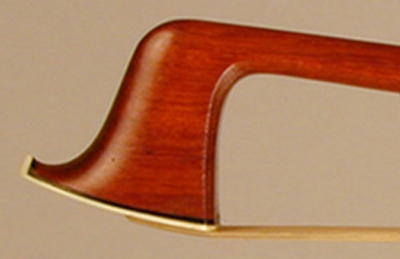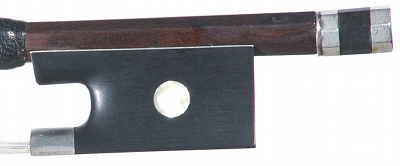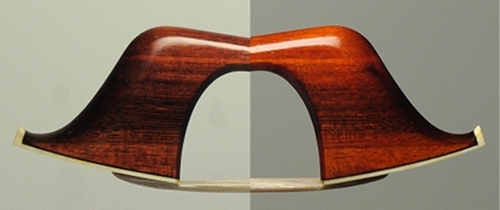EXPERTS' SECRETSI often hear the musicians say: " I do not care if my bow is original or not, I feel fine with it and that is enough." I have nothing to object provided that the bow has been paid the right price , otherwise you may face bad surprises! I know it is not a subject that could be of interest to instruments players, and I am fully aware that few lines written on a blog are not sufficient to give you the means to discern and recognize the bows by your own, but I think that knowing what the used parameters and criteria are, can be interesting for everyone. One of the most delicate parts of my job is to check the bows trying to give an "opinion" that could be as fair as possible about who the maker was. I use the word opinion, because as you already know, the only people authorized to write certificates on French bows and recognized all over the world are Mr. J.F. Raffin and Mr. B. Millant, if the certificate of your bow has not been issued by them, actually you do not have one! Obviously, my opinion is worth nothing, and for this reason, when I have a client who wants to know whether a bow is an original one, I carry it to Paris personally. Anyway, let's come back to us. To become a bow expert, as in all other fields, study and ability to observe are necessary along with the ability to remember and to relate what we already saw with what we are looking at. Violin Head Dominique Peccatte
These two photos show a Dominique Peccatte's head and one by Eugene Sartory. I took these bow makers as example, because apart from being two of the most important masters, they are stylistically very different. The thing that immediately catches the eye is the different development of the head, the Peccatte's one thrusts forward, recalling a ram shape, while the Sartory's one goes backwards. This direction of the head is given by two intersecting lines, that one of the inclination runs from the top of the shoe in ivory, called "house" and that one starting from the bottom of the bevel crossing the head through the top of the wedge. By changing the inclination of these two lines, obviously , also the development changes consequently. This is one of the details that immediately exclude the authenticity of the bow, when untreated, because from the relation between these two lines we get the harmonic movement of the head, as the masters knew. Besides this, the Peccatte, like all ancient heads, has a development of the profile more angular of the Sartory one , and the bevel of the first is very important, compared to the other. Sartory starts rather large and closes on the end by turning slightly inwards. Peccatte is almost the opposite, increasing the already large size of the start until the end and closing less. In addition the curve of the bevel is far greater than Sartory.
Violin Frog Dominique Peccatte
Also in the frog and the button you can see the great differences of style. In Peccatte the blade is shorter and stocky, its throat, as well, is not a regular circle and gives an impression of angularity, as in the head. Going into detail you can see that, before coming to the ring Peccatte gives the throat a short straight line, and tilt the opposite corner downwards. Sartory, on the contrary, comes to the ring with a curved line, and tilts the opposite corner towards the top. Also the button is different, even if, unfortunately, it cannot be properly detected in the pictures. You better note the proportions: in Peccatte the two metal parts have the same length, except for the collar. In Sartory the two sides, collar included, have the same length. Speaking of the collar, in Peccatte it is single and light while in Sartory,it is double and deeper, trust me even if you do not see properly. So far everything is alright. It is enough to observe, remember, and relate, but there is one more thing, or better two. At first, all the details stated above are not often found in a canonical way in every bow , hence the difficulty of the work of experts, furthermore everybody can copy some lines, just a nice hand is required. Mr. Raffin and Mr. Millant have published a huge and wonderful book, "L'Archet", which not only contains hundreds of photographs, but it also reveals the stick measures, the size of eyes and buttons, building characteristics, etc.. and you can consult it to make copies. But it does not say anything useful about how the bowmaker worked. Let me explain it better . Each craftsman, like any other human being has two eyes to see and two hands to work, and of course there are not two equal and it is precisely on this that the work of the expert is based. He has to know which were the hand and sight defects of the craftsman, and of course to know with which hand he worked, if the right or the left one. In this lays the interest of the real forger or people like me who studies the bows and, of course, the great masters know this, but unfortunately they do not tell it to you . The working hand is guided and regulated by two factors: defective eyesight and work posture. If the author has a visual defect, such as astigmatism, he will see a a straight line as crooked and the crooked one as straight. It 's a bit like color blindness, a color-blind sees green if you show him a red color. By knowing the sight defects of the maker, you can tell if the bow is original, because although it is relatively easy to copy a style, it is virtually impossible to replicate an error. As it is impossible for a right-handed to copy a left-handed. A great luck of one of the largest trader-expert of the nineteenth century, J.B. Vuillaume, for example, is to have found a craftsman who had the same sight defect of Stradivari. He hired him and he made him build Strad-style scrolls all during his life. That's why there is more than one Stradivarius instrument smelling of escargots, but no one dares to say with certainty that it is a fake. As I said, the two sides of head and frog, are worked in a different ways, this is why there is no perfect equality between the left and right side of the bow. The hand of the bowmaker has to carry out diametrically opposed movements, creating the same aesthetic. While for a right-handed the cheek of the head that works best is the right one, it is opposite for a left-handed, so knowing that the bowmaker is left-handed, as Maestro Navea Vera for example, if you get a bow with his stamp, but made by a right-handed , it's definitely a fake. You will not believe it, but it happened to me. Violin Head D.T. Navea Vera Some practical example. If you look at the way in which a bow is shown in the picture, you can see, at the same time, both sides of the head and the middle line. At a first glance, the mid-line appears to be perfectly straight, but if you look closely at it, you will see that it has a small ripple towards right in the bottom half. Besides, I know that it cannot be seen but trust me once again, the lines on the left side are a little bit sweeter and fluider than on the right one. Cello head D.T. Navea Vera Also in the bevel, you can see with which hand the bowmaker works. If , as in this case, the craftsman is left-handed the right side will open up more than the left one, thanks to the movement of the hand. We thank the site http://www.tarisio.com for the photos of this post, you can click on the link to access to their archive. So long Paolo
|
   |










